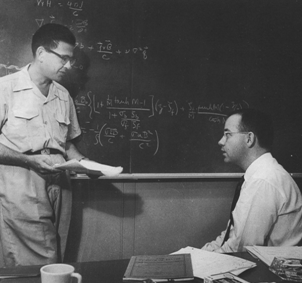- 1610: Galileo
- 1676: Ole Rømer
- 1687: Isaac Newton
- 1781: William Herschel
- 1838: Friedrich Bessel
- 1861: William and Margaret Huggins
- 1912: Henrietta Leavitt
- 1917 Einstein
- 1920: Harlow Shapley
- 1929 Edwin Hubble
- 1948: Ralph Alpher
- 1949: Fred Hoyle
- 1963: Maarten Schmidt
- 1964: Arno Penzias and Robert Wilson
- 1978: Vera Rubin and Kent Ford
- 1989: Margaret Geller and John Huchra
- 1992: John Mather and George Smoot
- 1995: Robert Williams
- 1998: Saul Perlmutter and Brian Schmidt
- 2010: Wendy Freedman
1948: Ralph Alpher and the Big Bang
 |
| Image of Ralph Alpner and Charles Muckenfuss. Reprinted with permission of Victor S. Alpher, Ph.D., Executor of the Estate of Ralph A. Alpher, from the personal photo collection of Ralph A. Alpher. All international copyrights reserved. |
The idea that the universe might not be static and eternal but instead constantly changing seemed far-fetched when proposed by Ukrainian mathematician Alexander Friedmann. Edwin Hubble’s discovery in 1929 that the universe is expanding focused attention on the idea that the universe may have started with some sort of explosion, but there was no sensible explanation for how such a beginning could produce the elements in the universe today.
The challenge of developing a feasible model of the Big Bang theory was taken up by George Gamov at George Washington University, and a brilliant student, Ralph Alpher, who had the mathematical talent necessary to develop a convincing mathematical description of how the universe could have evolved.
The seeds of the Big Bang theory were laid by the Alexander Friedmann, who had the courage to examine the full implications of Einstein’s general theory of relativity for cosmology—that the universe may not be static. It could be expanding or contracting. Few people took Friedmann seriously and his work was little known. The idea was independently proposed by Georges Lemaître, a Belgian Priest, whose theory that the universe began with the decay of a single atom was also found wanting because it, too, could not explain how hydrogen and helium, the building blocks of the other elements, were formed.
Gamow and Alpher tackled the problem by starting with the density of matter in the universe today and running the clock backward, envisioning what would happen if everything were compressed into a denser and denser state. As pressure increased the temperature would rise, and molecules would be broken down into atoms, and atoms into their constituent parts. When they got to the smallest possible components they ran the clock forwards, envisioning how the atoms would coalesce out of the mixture of particles that that they called ylem, an old English word meaning “the primordial substance from which the elements were formed.”
The mathematical genius, Ralph Alpher, showed that the expansion of the universe from an initial ultra-dense state would indeed produce all of the elementary particles needed to assemble hydrogen and helium in the proportions seen in the universe today in just a few minutes. This was an important result because hydrogen and helium make up 99.99% of the matter in today’s universe. This time the world took notice and on April 14, 1948 the Washington Post carried the headline “World Began in 5 Minutes.”
Alpher made an even more important discovery a few months later with the assistance of fellow physicist Robert Herman as they continued to refine a mathematical model of how the universe would have unfolded. In addition to matter, energy would have been present in the form of light. At first the light would have been scattered by the electrons and protons in the extremely hot early universe, but after about 300,000 years the universe would have been cool enough for electrons and protons to join, forming atoms which do not absorb light. For the first time light would be free to travel throughout the universe. At that moment the universe would have cooled to about 3,000 °C, and the light that was released would have had the characteristic color of a glowing red coal. Since the universe as a whole was expanding the researchers predicted that the light that was released would have shifted toward longer wavelengths due to the Doppler shift, and would now be observed at a wavelength of about one millimeter—in the microwave range.
Explaining known phenomena—the current abundance of hydrogen and helium in the universe and the expansion of the universe observed by Hubble—made the Big Bang theory credible. But the prediction of a phenomenon that had not yet been detected made it a truly scientific theory since it could be tested. Unfortunately, it still seemed too far-fetched for astronomers to use their valuable time building the equipment they would need to search for the predicted microwaves. A test of the theory would need to wait until researchers stumbled on the predicted radiation fifteen years later.